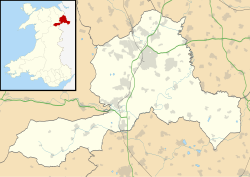Administrative history
Holt was an ancient parish. It was subdivided into six townships: Cacca Dutton, Dutton Diffeth, Dutton-y-Bran, Ridley, Sutton, and a Holt township covering the northern part of the parish including Holt itself and adjoining countryside. [8] From the 17th century onwards, parishes were gradually given various civil functions under the poor laws, in addition to their original ecclesiastical functions. In some cases, including Holt, the civil functions were exercised by each township separately rather than the parish as a whole. In 1866, the legal definition of 'parish' was changed to be the areas used for administering the poor laws, and so the townships also became civil parishes. [9] The five southern townships from the old parish were merged into a new civil parish called Isycoed in 1935. [10]
Holt anciently formed part of the cantref of Maelor within the Kingdom of Powys. The area was contested between English and Welsh rulers between the 11th and 13th centuries. By the 13th century, Maelor was split into Maelor Saesneg (English Maelor) and Maelor Gymraeg (Welsh Maelor), also known as Bromfield. Holt was in Bromfield, which became part of Denbighshire on the county's creation in 1536. [11]
Holt was also an ancient borough, having been incorporated under a municipal charter issued by Thomas Fitzalan, 5th Earl of Arundel, around 1409. By the 19th century the borough had very few functions, an so it was left unreformed when most boroughs were converted into municipal boroughs in 1836. The borough was eventually abolished in 1886. [12] [13]
The civil parish of Holt was converted into a community and became part of the new borough of Wrexham Maelor in Clwyd in 1974 under the Local Government Act 1972. [14] [15] The upper tiers of local government were reorganised again in 1996, when the modern county borough of Wrexham was created. [16]








